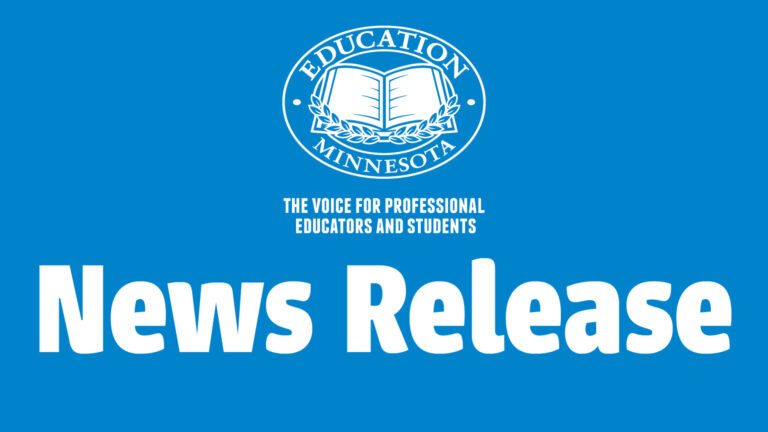For more information, contact:
CHRIS WILLIAMS
651-292-4816 (work)
651-247-5539 (cell)
SAINT PAUL, Minnesota. May 20, 2023 – Most Minnesota teachers would be able to retire with a full pension a year earlier under a provision in the omnibus tax bill approved by the Legislature over the weekend. The bill now heads to Gov. Tim Walz for his signature.
The provision would spend more than $97 million in ongoing funding to lower the normal retirement age from 66 to 65 for teachers in the Minnesota Teacher Retirement Association, or TRA, and St. Paul Teachers’ Retirement Fund Association pension plans. The 2023 tax bill would increase employers’ contribution to the TRA by .75 percent and the employee contribution will go up by .25 percent. The lowering of the retirement age and the contribution increases are effective July 1, 2025.
Education Minnesota President Specht said pension reform is overdue in Minnesota. The normal retirement age of 66 in the TRA is the third oldest in the nation due to changes made to the plan since 1989. Lowering the normal retirement age to 65 would make the plans more competitive with neighboring states, but the TRA plan would still lack consideration for long-term service that most plans contain; it continues to over-penalize early retirement; the gap in benefits between teachers hired before and after July 1, 1989, remains too large; and other shortcomings.
“Teaching has gotten so much harder since 1989, it just makes sense to make a full pension easier to access for the teachers who have given so much to our state,” Specht said. “Pensions are also an important recruiting tool for talented people considering teaching as a career because the state of Minnesota is offering something corporate America never will – a defined-benefit pension with a reasonable retirement age. The new changes aren’t enough, but they are a step in the right direction, and they open the door to more improvements in the future. Our union will keep pushing.”
Also Saturday, Specht praised the omnibus bills for E-12 education, labor and higher education, which have all passed both the House and Senate. The governor is expected to sign them into law next week.
“There is a life-changing package of funding and policy for educators and students in these three bills, if the education money is spent correctly by the districts and campuses,” Specht said. “The education bill adds billions of dollars to E-12 education with an inflation adjustment that will stabilize school funding for years. The labor bill empowers more educators to negotiate together and expands the topics of bargaining to include student-to-staff ratios to give educators and parents more guarantees that the new money will be well spent. The higher education bill provides free college to the neediest students, freezes tuition and makes a historic investment in the quality of education offered in the state’s two- and four-year public colleges. This will be a historic session of the Legislature for educators, parents and students.”
Specht thanked Gov. Walz, Lt. Gov. Peggy Flanagan, House Speaker Melissa Hortman, Senate Majority Leader Kari Dziedzic and all the committee chairs and bill authors for their unflinching support for public education and educators this session.
“Last year, Minnesota’s educators worked hard to elect leaders who cared about working people and the state’s schools and campuses, but the job didn’t end on Election Day,” Specht said. “Tens of thousands of educators contacted their lawmakers this session and thousands of educators came to the Capitol personally to advocate for our students and our profession. Five months later, Gov. Walz and the pro-education majorities in the House and Senate have delivered on their promises, which will benefit every Minnesota student, worker, family and educator.”
Highlights of the education omnibus bill includes $5.5 billion in new funding over the next four fiscal years and:
- An approximately 11 percent increase to the state’s financial support for E-12 public education in the first two-year budget and a 15 percent increase in the following two years.
- An increase to the state’s per-pupil formula of 4 percent in the first year of the budget and 2 percent in the second year of the next budget.
- An automatic inflationary increase to the state E-12 education budget of 2 percent to 3 percent each year starting in 2026.
- Increasing state coverage of the special education and English language learner cross subsidies to 50 percent of the special education subsidy, and 83 percent of the English language learner subsidy, by 2027.
- $64 million in the next biennium for increased student support personnel to address shortages of counselors, psychologists, social workers, nurses, and chemical dependency counselors in Minnesota schools.
- A one-time investment of $135 million to give hourly educators, such as education support professionals, access to unemployment insurance during the summer.
- $60 million in the next biennium for the Increase Teachers of Color Act and millions more for teachers licensed to work with students with special needs.
- Full-service community schools would receive a $7.5 million boost for two years and then $5 million per year in the future.
Highlights of the labor omnibus bill include:
- Expanding topics of bargaining to include staffing ratios in public schools. The bill doesn’t set a specific ratio of students to educators, but it does require a conversation during collective bargaining about how to meet students’ needs.
- Providing the same continuing contract and due process protections for early childhood and adult education teachers as K-12 teachers, which should lead to increased compensation and more professional respect for the teachers of districts’ youngest and oldest students.
- Permitting teachers with Tier 1 licenses to join the same bargaining unit as teachers with higher-tier licenses, making it more likely teachers with Tier 1 licenses will receive employer-paid professional development and higher compensation.
Highlights of the higher education omnibus bill include:
- A historic 12 percent increase in funding Minnesota State’s two- and four-year higher education campuses.
- North Star Promise “last dollar” scholarships to pay all tuition and fees at Minnesota’s public colleges and universities for students with a household income under $80,000.
- Tuition freezes for current students at all Minnesota State colleges and universities.
- An additional $50 million in one-time money for campuses to shore up budgets and address ongoing structural deficits.
About Education Minnesota
Education Minnesota is the voice for professional educators and students. Education Minnesota’s members include teachers and education support professionals in Minnesota’s public school districts, faculty members at Minnesota’s community and technical colleges and University of Minnesota campuses in Duluth and Crookston, retired educators and student teachers. Education Minnesota is affiliated with the American Federation of Teachers, National Education Association and AFL-CIO.




